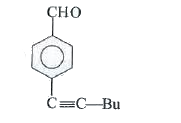Compound C of the above reaction cannot be :




The correct Answer is:A,B,C
To solve the question regarding the transformation of the compound Bu-C≡CH through a series of reactions, we will break down each step and identify the final product C, while also determining which compound cannot be C.
1. Starting Compound:
- We begin with Bu-C≡CH (but-1-yne).
2. Reaction with LiNH₂ and H₂:
- When Bu-C≡CH is treated with lithium amide (LiNH₂) and hydrogen (H₂), the terminal alkyne hydrogen is replaced by a lithium ion, resulting in the formation of a lithium acetylide.
- This gives us Compound A: Bu-C≡C⁻Li⁺.
3. Reaction with PhCHO (Benzaldehyde):
- The lithium acetylide (C≡C⁻) acts as a nucleophile and attacks the carbonyl carbon of benzaldehyde (PhCHO), leading to the formation of an alkoxide intermediate.
- This results in Compound B: Ph-CH(OH)-C≡C-Bu.
4. Hydrolysis with H₂O:
- The alkoxide intermediate is then treated with water (H₂O), which protonates the alkoxide, yielding an alcohol.
- Thus, Compound B becomes: Ph-CH(OH)-C≡C-Bu.
5. Oxidation with MnO₂:
- The alcohol (Ph-CH(OH)-C≡C-Bu) is then oxidized using manganese dioxide (MnO₂), converting the alcohol into a ketone.
- This results in Compound C: Ph-C(=O)-C≡C-Bu.
Conclusion:
Now, we need to identify which compound cannot be Compound C.
- Possible Structures for Compound C:
- The structure of Compound C is expected to have a phenyl group (Ph), a carbonyl group (C=O), and a terminal alkyne (C≡C) connected to butyl (Bu).
- Analysis of Options:
- If any of the options provided in the question include a structure that has:
- An aldehyde group (CHO) instead of a ketone (C=O).
- Any other functional group that does not match the expected structure of Compound C.
From the analysis, we conclude that Compound C cannot have an aldehyde group (CHO) attached to it, as it must have a ketone functional group.
Final Answer:
Compound C of the above reaction cannot be CHO - C≡C - Bu (or any structure that includes an aldehyde instead of a ketone).
- We begin with Bu-C≡CH (but-1-yne).
- When Bu-C≡CH is treated with lithium amide (LiNH₂) and hydrogen (H₂), the terminal alkyne hydrogen is replaced by a lithium ion, resulting in the formation of a lithium acetylide.
- This gives us Compound A: Bu-C≡C⁻Li⁺.
- The lithium acetylide (C≡C⁻) acts as a nucleophile and attacks the carbonyl carbon of benzaldehyde (PhCHO), leading to the formation of an alkoxide intermediate.
- This results in Compound B: Ph-CH(OH)-C≡C-Bu.
- The alkoxide intermediate is then treated with water (H₂O), which protonates the alkoxide, yielding an alcohol.
- Thus, Compound B becomes: Ph-CH(OH)-C≡C-Bu.
- The alcohol (Ph-CH(OH)-C≡C-Bu) is then oxidized using manganese dioxide (MnO₂), converting the alcohol into a ketone.
- This results in Compound C: Ph-C(=O)-C≡C-Bu.
Now, we need to identify which compound cannot be Compound C.
- The structure of Compound C is expected to have a phenyl group (Ph), a carbonyl group (C=O), and a terminal alkyne (C≡C) connected to butyl (Bu).
- Analysis of Options:
- If any of the options provided in the question include a structure that has:
- An aldehyde group (CHO) instead of a ketone (C=O).
- Any other functional group that does not match the expected structure of Compound C.
From the analysis, we conclude that Compound C cannot have an aldehyde group (CHO) attached to it, as it must have a ketone functional group.
Compound C of the above reaction cannot be CHO - C≡C - Bu (or any structure that includes an aldehyde instead of a ketone).
Topper's Solved these Questions
Similar Questions
Knowledge Check
Bu−C≡ChNaNH2−−−−→APh−CHO−−−−−→H2OBMnO2−−−→C
Compound C of the reaction cannot be :A B
B C
C D
D
Ph−O∣∣C−CH3NaNO2−−−−→HCl(A)AC2O−−→heat(B)H3O+−−−→(C)
Product ( C) of the above reaction is :APh−CO2HBPh−O∣∣C−CO2HCPh−O∣∣C−O∣∣C−HDPh−O∣∣C−CH2OHR−CH=CH−CHO+NH2−O||C−NHNH2H+−−→X
(X) in the above reaction isAR−CH=CH−OH∣CH−NH2CONHNH2BR−CH=CH−CH=N−NH−O||C−NH2CR−CH=NH2CONH2DR−CH=CH−CH∣OH−NH2COCH=NHNH2
C2H5CNHNO2−−−→APCl5−−→BNH3−−→C end product in the given sequence is
View SolutionCH2=CH−CH2OHPhH/HF−−−−−→IAH2/Pt−−−→IIBNBS−−→IIICH2O,acetone−−−−−−−→IVDMnO2−−−→VE
Which of the following statement is/are correct ?
View SolutionPhenol (i) NaOH−−−−→(ii) CO2(A)H+/H2O−−−−−→(B)Ac2O−−→(C)
In this reaction , identify the incorrect statement?
View SolutionPhenol Zn-dust−−−→AConc.HNO3−−−−−−→+H2SO4BZn−−−→NaOHC
in the above reaction A, B and C are :
View SolutionCompounds (A) and (C ) in the following reactions are
CH3CHO(i)CH3MgBr−−−−−−−−→(ii)H2O(A)H2SO4,Δ−−−−−−→(B)Hydroboration oxidation−−−−−−−−−−−−−−→(C)
View Solution


